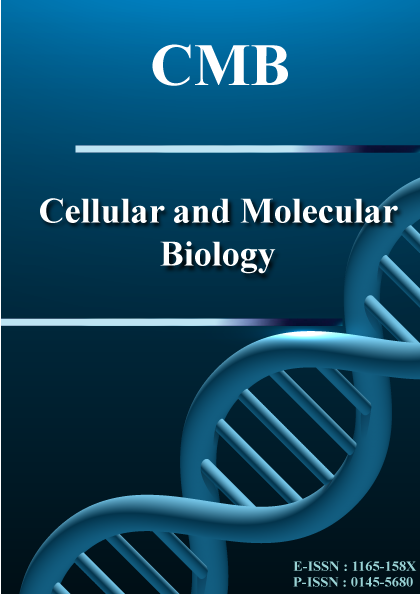Issue
Copyright (c) 2025 Nor Azma Hannah Mazlan, Mohd Hamzah Mohd Nasir, Farah Wahida Ibrahim, Asmah Hamid, Iffah Nadiah Laili, Nurul Farhana Jufri

This work is licensed under a Creative Commons Attribution-NonCommercial-NoDerivatives 4.0 International License.
The undersigned hereby assign all rights, included but not limited to copyright, for this manuscript to CMB Association upon its submission for consideration to publication on Cellular and Molecular Biology. The rights assigned include, but are not limited to, the sole and exclusive rights to license, sell, subsequently assign, derive, distribute, display and reproduce this manuscript, in whole or in part, in any format, electronic or otherwise, including those in existence at the time this agreement was signed. The authors hereby warrant that they have not granted or assigned, and shall not grant or assign, the aforementioned rights to any other person, firm, organization, or other entity. All rights are automatically restored to authors if this manuscript is not accepted for publication.The effects of lysosomal dysfunction on cytoplasmic vacuolation and amyloid-beta 40 (Aß40) level in human brain endothelial cells (HBEC-5i)
Corresponding Author(s) : Nurul Farhana Jufri
Cellular and Molecular Biology,
Vol. 71 No. 4: Issue 4
Abstract
Lysosomes are an important intracellular organelle that regulates cellular degradation. Dysfunctional lysosomes disrupt this process, leading to the accumulation of toxic proteins that are meant to be degraded inside the cell, leading to cellular stress and potential toxicity. One of the proteins is beta-amyloid which is associated with conditions like cerebral amyloid angiopathy (CAA) and Alzheimer's disease (AD). To identify its effects on the vascular compartment, the current study explored lysosomal dysfunction's impact on cytosolic vacuole formation and amyloid beta 40 (Aß40) levels in human brain endothelial cells (HBEC-5i). Cells treated with the lysosomotropic compound chloroquine (70.5 µM) exhibited morphological changes, including prominent cytosolic vacuole formation. The vacuole density was recorded at 11.86 ± 1.907 vacuoles per cell (p < 0.05), and its diameter was significantly increased (3.76 ± 0.182 µm, p < 0.05) compared to the negative control group. However, the average cell size remained unchanged despite the vacuole formation in CQ-treated cells. ELISA tests on lysate and supernatant revealed no significant differences between treatment and control groups in intracellular and extracellular Aß40 levels. This suggested that while lysosomal dysfunction induced cytosolic vacuole changes, it did not significantly alter Aß40 levels. Further research is needed to elucidate the pathways involved in Aß40.
Keywords
Download Citation
Endnote/Zotero/Mendeley (RIS)BibTeX




